Benjamin Alt
Digital Twin Generation from Visual Data: A Survey
Apr 17, 2025Abstract:This survey explores recent developments in generating digital twins from videos. Such digital twins can be used for robotics application, media content creation, or design and construction works. We analyze various approaches, including 3D Gaussian Splatting, generative in-painting, semantic segmentation, and foundation models highlighting their advantages and limitations. Additionally, we discuss challenges such as occlusions, lighting variations, and scalability, as well as potential future research directions. This survey aims to provide a comprehensive overview of state-of-the-art methodologies and their implications for real-world applications. Awesome list: https://github.com/ndrwmlnk/awesome-digital-twins
AI-based Framework for Robust Model-Based Connector Mating in Robotic Wire Harness Installation
Mar 12, 2025Abstract:Despite the widespread adoption of industrial robots in automotive assembly, wire harness installation remains a largely manual process, as it requires precise and flexible manipulation. To address this challenge, we design a novel AI-based framework that automates cable connector mating by integrating force control with deep visuotactile learning. Our system optimizes search-and-insertion strategies using first-order optimization over a multimodal transformer architecture trained on visual, tactile, and proprioceptive data. Additionally, we design a novel automated data collection and optimization pipeline that minimizes the need for machine learning expertise. The framework optimizes robot programs that run natively on standard industrial controllers, permitting human experts to audit and certify them. Experimental validations on a center console assembly task demonstrate significant improvements in cycle times and robustness compared to conventional robot programming approaches. Videos are available under https://claudius-kienle.github.io/AppMuTT.
QueryCAD: Grounded Question Answering for CAD Models
Sep 16, 2024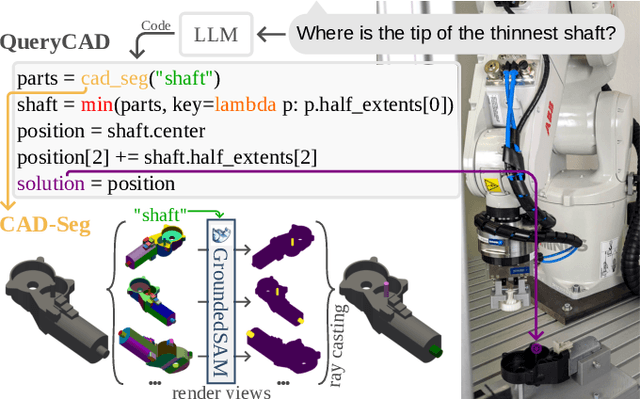

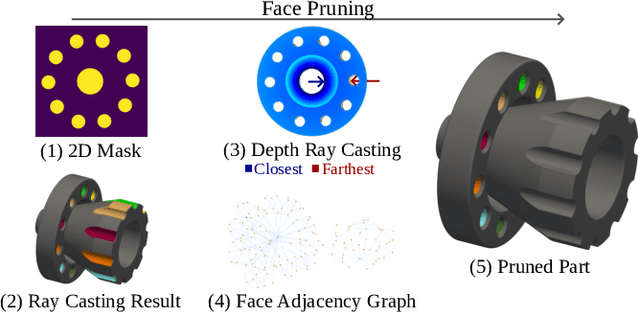
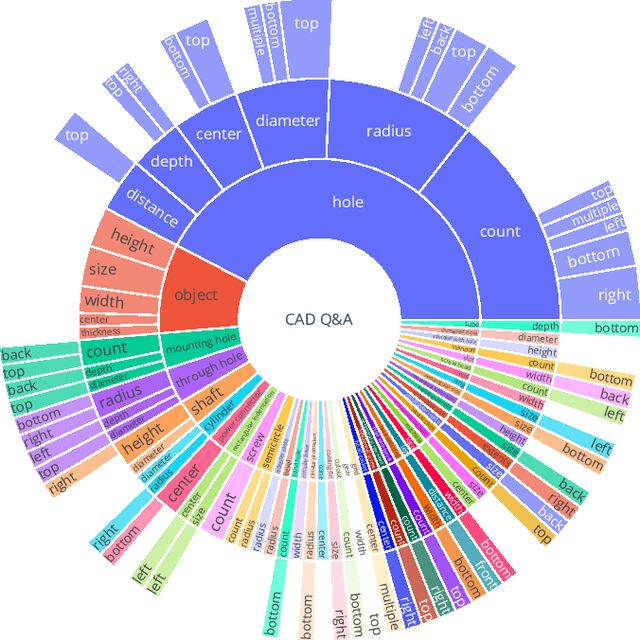
Abstract:CAD models are widely used in industry and are essential for robotic automation processes. However, these models are rarely considered in novel AI-based approaches, such as the automatic synthesis of robot programs, as there are no readily available methods that would allow CAD models to be incorporated for the analysis, interpretation, or extraction of information. To address these limitations, we propose QueryCAD, the first system designed for CAD question answering, enabling the extraction of precise information from CAD models using natural language queries. QueryCAD incorporates SegCAD, an open-vocabulary instance segmentation model we developed to identify and select specific parts of the CAD model based on part descriptions. We further propose a CAD question answering benchmark to evaluate QueryCAD and establish a foundation for future research. Lastly, we integrate QueryCAD within an automatic robot program synthesis framework, validating its ability to enhance deep-learning solutions for robotics by enabling them to process CAD models (https://claudius-kienle.github.com/querycad).
Shadow Program Inversion with Differentiable Planning: A Framework for Unified Robot Program Parameter and Trajectory Optimization
Sep 13, 2024



Abstract:This paper presents SPI-DP, a novel first-order optimizer capable of optimizing robot programs with respect to both high-level task objectives and motion-level constraints. To that end, we introduce DGPMP2-ND, a differentiable collision-free motion planner for serial N-DoF kinematics, and integrate it into an iterative, gradient-based optimization approach for generic, parameterized robot program representations. SPI-DP allows first-order optimization of planned trajectories and program parameters with respect to objectives such as cycle time or smoothness subject to e.g. collision constraints, while enabling humans to understand, modify or even certify the optimized programs. We provide a comprehensive evaluation on two practical household and industrial applications.
MuTT: A Multimodal Trajectory Transformer for Robot Skills
Jul 22, 2024



Abstract:High-level robot skills represent an increasingly popular paradigm in robot programming. However, configuring the skills' parameters for a specific task remains a manual and time-consuming endeavor. Existing approaches for learning or optimizing these parameters often require numerous real-world executions or do not work in dynamic environments. To address these challenges, we propose MuTT, a novel encoder-decoder transformer architecture designed to predict environment-aware executions of robot skills by integrating vision, trajectory, and robot skill parameters. Notably, we pioneer the fusion of vision and trajectory, introducing a novel trajectory projection. Furthermore, we illustrate MuTT's efficacy as a predictor when combined with a model-based robot skill optimizer. This approach facilitates the optimization of robot skill parameters for the current environment, without the need for real-world executions during optimization. Designed for compatibility with any representation of robot skills, MuTT demonstrates its versatility across three comprehensive experiments, showcasing superior performance across two different skill representations.
Human-AI Interaction in Industrial Robotics: Design and Empirical Evaluation of a User Interface for Explainable AI-Based Robot Program Optimization
Apr 30, 2024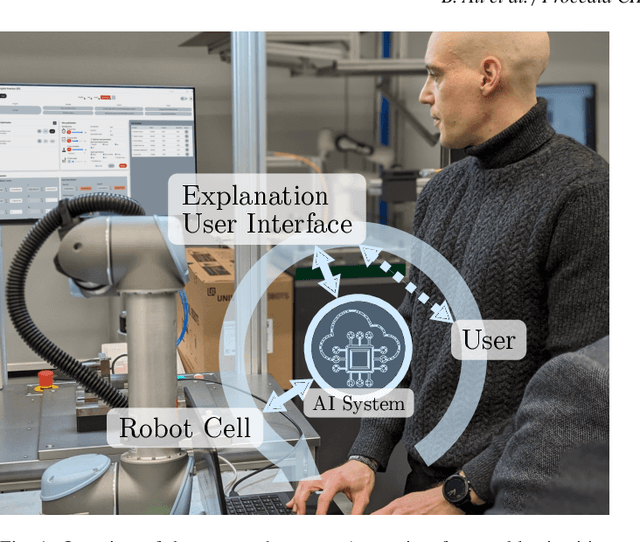


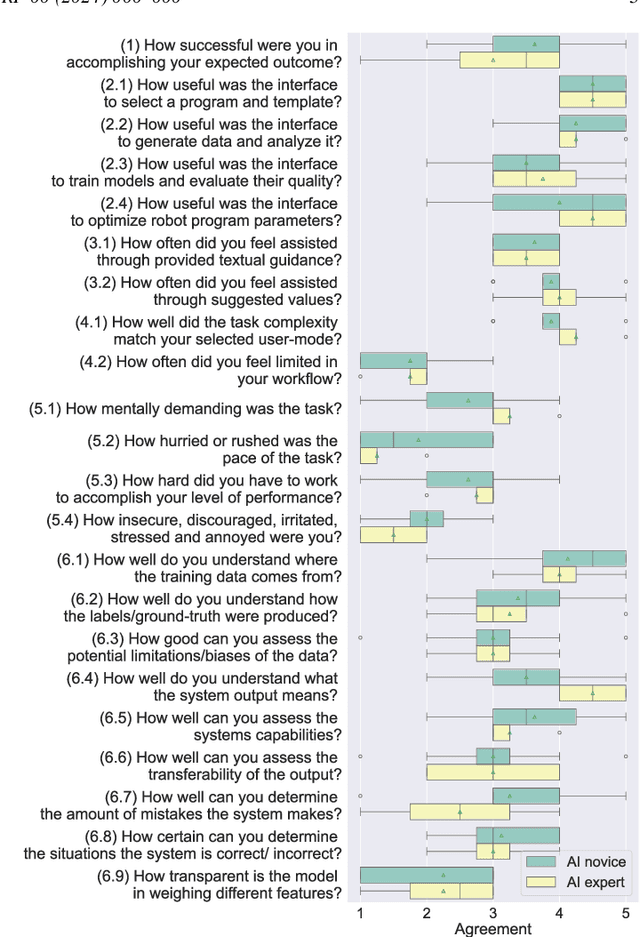
Abstract:While recent advances in deep learning have demonstrated its transformative potential, its adoption for real-world manufacturing applications remains limited. We present an Explanation User Interface (XUI) for a state-of-the-art deep learning-based robot program optimizer which provides both naive and expert users with different user experiences depending on their skill level, as well as Explainable AI (XAI) features to facilitate the application of deep learning methods in real-world applications. To evaluate the impact of the XUI on task performance, user satisfaction and cognitive load, we present the results of a preliminary user survey and propose a study design for a large-scale follow-up study.
BANSAI: Towards Bridging the AI Adoption Gap in Industrial Robotics with Neurosymbolic Programming
Apr 21, 2024


Abstract:Over the past decade, deep learning helped solve manipulation problems across all domains of robotics. At the same time, industrial robots continue to be programmed overwhelmingly using traditional program representations and interfaces. This paper undertakes an analysis of this "AI adoption gap" from an industry practitioner's perspective. In response, we propose the BANSAI approach (Bridging the AI Adoption Gap via Neurosymbolic AI). It systematically leverages principles of neurosymbolic AI to establish data-driven, subsymbolic program synthesis and optimization in modern industrial robot programming workflow. BANSAI conceptually unites several lines of prior research and proposes a path toward practical, real-world validation.
RoboGrind: Intuitive and Interactive Surface Treatment with Industrial Robots
Feb 27, 2024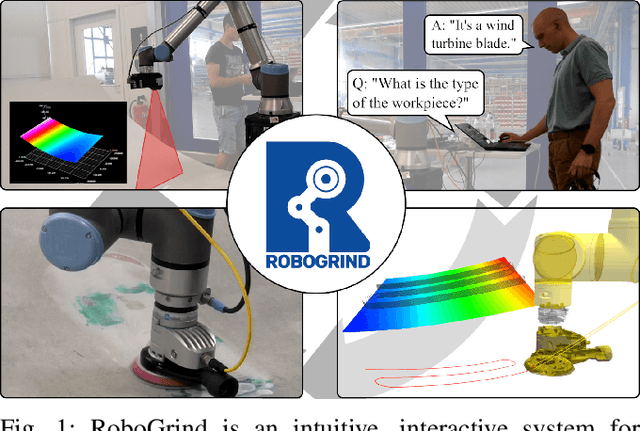
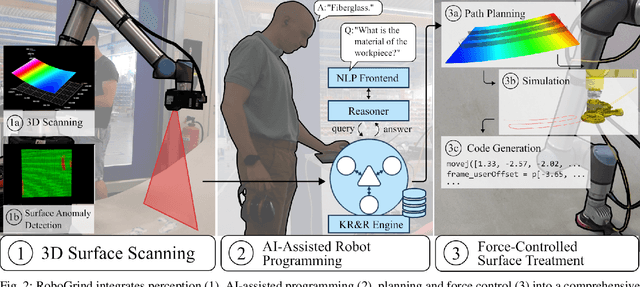

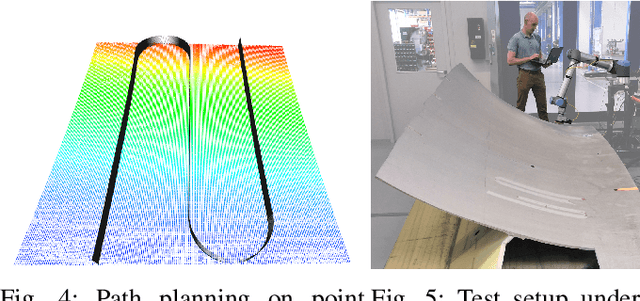
Abstract:Surface treatment tasks such as grinding, sanding or polishing are a vital step of the value chain in many industries, but are notoriously challenging to automate. We present RoboGrind, an integrated system for the intuitive, interactive automation of surface treatment tasks with industrial robots. It combines a sophisticated 3D perception pipeline for surface scanning and automatic defect identification, an interactive voice-controlled wizard system for the AI-assisted bootstrapping and parameterization of robot programs, and an automatic planning and execution pipeline for force-controlled robotic surface treatment. RoboGrind is evaluated both under laboratory and real-world conditions in the context of refabricating fiberglass wind turbine blades.
Domain-Specific Fine-Tuning of Large Language Models for Interactive Robot Programming
Dec 21, 2023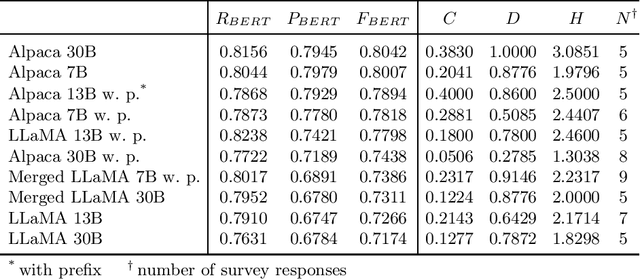
Abstract:Industrial robots are applied in a widening range of industries, but robot programming mostly remains a task limited to programming experts. We propose a natural language-based assistant for programming of advanced, industrial robotic applications and investigate strategies for domain-specific fine-tuning of foundation models with limited data and compute.
EfficientPPS: Part-aware Panoptic Segmentation of Transparent Objects for Robotic Manipulation
Dec 21, 2023Abstract:The use of autonomous robots for assistance tasks in hospitals has the potential to free up qualified staff and im-prove patient care. However, the ubiquity of deformable and transparent objects in hospital settings poses signif-icant challenges to vision-based perception systems. We present EfficientPPS, a neural architecture for part-aware panoptic segmentation that provides robots with semantically rich visual information for grasping and ma-nipulation tasks. We also present an unsupervised data collection and labelling method to reduce the need for human involvement in the training process. EfficientPPS is evaluated on a dataset containing real-world hospital objects and demonstrated to be robust and efficient in grasping transparent transfusion bags with a collaborative robot arm.
* 8 pages, 8 figures, presented at the 56th International Symposium on Robotics (ISR Europe)
 Add to Chrome
Add to Chrome Add to Firefox
Add to Firefox Add to Edge
Add to Edge